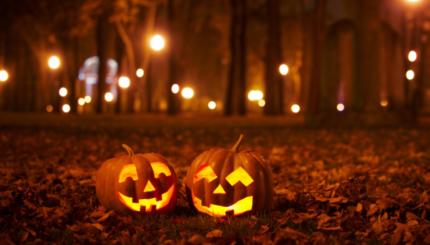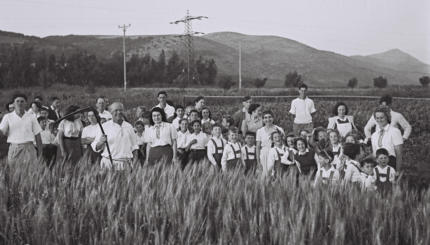The Holocaust Scroll
There have been a few attempts in recent years to create liturgy for Yom Hashoah. One attempt was undertaken by the Reform movement in the 1980’s with the publication of Six Days of Destruction, a liturgy where the stories of survivors–written by Elie Wiesel– were contrasted to the six days of creation. The latest attempt at creating a liturgical piece was unveiled by the Conservative movement at a Yom Hashoah service in Toronto, Canada in May 2003. Reprinted with permission of The Forward.
In a revolutionary attempt to ritualize the observance of Holocaust Remembrance Day, the Conservative movement has produced the first-ever formal liturgy for the holiday.
Dubbed “Megillat Hashoah“–“The Scroll of the Holocaust”–the document was recited publicly for the first time in North America during an April 29 ceremony here at Beth David B’nai Israel Beth Am Synagogue [in Toronto]. About 1,100 worshipers turned out for the event, which marked Holocaust Remembrance Day, or Yom Hashoah.
Holocaust Remembrance Day was fixed by the Israeli government during the 1950s as an annual observance on the Hebrew date corresponding to the anniversary of the Warsaw Ghetto Uprising in April 1943. Adopted over the years by Jewish communities around the world, it is commonly marked with a patchwork of poetry readings, musical performances, and speeches by Holocaust survivors, communal leaders, and politicians. In recent years, however, rabbis and theologians–particularly in the Diaspora–have complained that the holiday needs a formalized and less secular set of rituals if it is to outlive the last generation of Holocaust survivors.
With your help, My Jewish Learning can provide endless opportunities for learning, connection and discovery.
The Need for a New Liturgy
The new Conservative liturgy, unveiled last year in Israel, represents the first attempt by a major Jewish religious movement to address the void. “Having one central text, shared by Jews wherever they live, will unite us and make possible the perpetuation of the story,” Rabbi Reuven Hammer, president of the Rabbinical Assembly, wrote in one of three introductions to the Megillah. “It will help us to fill what has become the new imperative of Jewish life: We must all view ourselves as if we had personally experienced the Shoah.”
Following the ceremony in Toronto, worshippers interviewed by the Forward said that the Megillah was an important development.
“I felt it was a necessity, and I’ll be here again every year that I can,” said Norm Solomon, a longtime member of Beth David. “It was very moving. I just wish there would have been more young people here to be a part of it.”
Past Attempts Have Failed
Previous attempts to infuse the holiday with religious overtones have met with resistance. In 2000, controversy erupted in Philadelphia when a Conservative rabbi instituted a day of silence as a theological rebuke of God. In response, Ruth Littner Shaw of the Philadelphia chapter of Sons and Daughters of Holocaust Survivors wrote a letter to the Jewish Exponent in defense of the holiday’s current secular character.
“Yom Hashoah must not be characterized as a religious holiday,” she wrote, “but as a commemoration of our martyrs who perished under the Nazi war machine, and a tribute to those who survived.”
Despite such sentiments, the Rabbinical Assembly and the Conservative movement’s rabbinical seminary in Israel, the Schechter Institute, have published the new Megillah. It was written by Avigdor Shinan, a professor of Hebrew literature at Hebrew University in Jerusalem, with the help of an academic committee.
Addressing the gathering in Toronto, Shinan told worshippers that the Megillah had been written through him, not by him. “I sat down at the computer, and after six hours the first draft emerged,” said Shinan, the son of Holocaust survivors. “It was as if somebody was moving my hand and my head.”
Contents of the New Megillah
The six-chapter Megillah is built largely around first-person testimonies. After an opening chapter that gives a searing overview of the victims’ suffering, it offers composite sketches of a Christian journalist observing life in the Warsaw Ghetto, a Jewish woman in a work camp, and a Jewish youth who was forced to pull out the teeth from his brother’s corpse and shove other dead bodies into ovens. A fifth chapter consists of a eulogy for those who died in the Holocaust; the final chapter recounts the efforts to rebuild Jewish life after the war ended.
Organizers of the Megillah say that, in addition to supplying a set ritual, the new document is meant to address theological questions posed by the Holocaust but often ignored at communal ceremonies.
In one chapter, the woman in the work camp blames the Jews of Europe for ignoring the rising tide of anti-Semitism and rejecting the advice to “emigrate to the distant east.” Others place the question–though not necessarily direct blame–at God’s feet.
The overriding theological message of the Megillah is that human beings have a right to question the divine, but they cannot expect answer –and that even without answers, the Jewish faith in God endures. The Megillah ends with the exhortation: “Do not mourn too much, but do not sink into the forgetfulness of apathy. Do not allow days of darkness to return; weep, but wipe the tears away. Do not absolve and do not exonerate, do not attempt to understand. Learn to live without an answer. Through our blood, live!”
The Role of Ritual
In addition to reading the Megillah, several members of the Schechter Institute, including its president, Rabbi David Golinkin, have adopted the practice of fasting on Yom Hashoah.
“Historic events are remembered in Judaism only if they are anchored in religious rituals,” Golinkin wrote in his introduction to Megillat Hashoah. “The kindling of six torches by survivors in the courtyard of Yad Vashem is a meaningful ritual, but will it last when there are no living survivors?”
Adopting a fixed ritual for Holocaust Remembrance Day appears to fly in the face of an argument made in 1999 by Rabbi Ismar Schorsch, chancellor of the Jewish Theological Seminary and nominal head of Conservative Judaism. Writing in JTS Magazine, Schorsch argued that Yom Hashoah should be folded into Tisha B’Av, a fast day on the ninth day of the Hebrew month of Av that commemorates the destruction of the Second Temple and other historic Jewish tragedies. A JTS spokeswoman said Schorsch would not comment on the new Megillah because he had not read enough about it or enough of the Megillah itself to comment.
While the effort to merge the two holidays has been sidelined for now, Megillat Hashoah does incorporate elements of Tisha B’Av. For example, part of the new Megillah is supposed to be chanted in the same melody used on the Tisha B’Av to recite the biblical Book of Lamentations, the dark account of life in ancient Israel after the destruction of the First Temple.
As opposed to the practice on other holidays, a blessing is not recited over the reading of Megillat Hashoah, said Rabbi Philip Scheim, religious leader of Beth David and author of the third introduction.
How the Holocaust Scroll Came To Be
Scheim credited Alex Eisen, a Holocaust survivor and member of Beth David, for coming up with the idea for Megillat Hashoah. More than five years ago, Eisen suggested that creating a liturgical Megillah would supply a unifying structure for the holiday and enable Jewish communities to observe it in a more spiritual way.
“Yom Hashoah is a secular commemoration in most communities,” Scheim told the Forward. Eisen “wanted to make it into a religious commemoration.” The Rabbinical Assemly and the Schechter Institute agreed to back the proposal.
A dynamic fundraiser, Eisen collected $280,000 in Toronto to sustain the project.
Shinan said he was uncertain how widely his text would be used in coming years. The Megillah was read this year on the eve of Yom Hashoah in Conservative congregations throughout Israel and the next day, April 29, at the Schechter Institute.
“I think it will take a few years for Megillat Hashoah to become part of the knowledge of rabbis and teachers” in North America, Shinan said. “I wish that many people will read it, but I’m realistic at the same time.”


